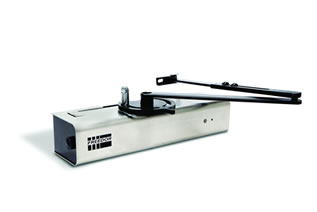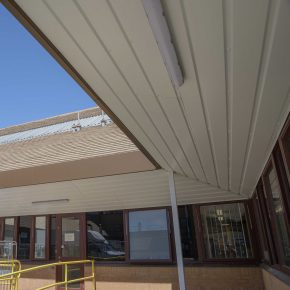
Fire safety and legal responsibilities of architects and builders
Non-compliance with legislation can have serious consequences as a property developer in Leicester found out in 2012 when he was fined £40k. Robert Alan Price allowed students to move into flats that did not have a fire escape or emergency exit signs or smoke detectors and fire doors were either missing or ill-fitting. Ensuring that all buildings meet the latest regulations in terms of fire safety and specifying adequate fire safety products and solutions should therefore be of paramount importance for architects and the construction industry.
Legal responsibilities before, during and after construction The legal requirements for fire safety will depend on whether the building is being constructed in accordance with standard Government Building Regulations or to British Standard BS 9999, which offers a barter option, giving greater flexibility to the standard building approach.
Emergency routes and exits must be clearly signed and kept clear
Building Regulations 2010, Approved Document B, describes the fire safety regulations for all buildings in England. For example, the regulation specifies that fire doors should take account of the needs of residents. In particular, where self-closing doors could present an obstacle to the residents of the building, then free-swing door closers on bedroom fire doors in accordance with BS EN 1155:1997 would be appropriate as well as hold-open devices in circulation spaces. This would be especially appropriate for residential care homes.
However, this document does not address the risk of fire during the construction work which is covered by the Construction (Design and Management) Regulations 2006. There are hundreds of fire incidents each year on construction sites which potentially put the lives of construction workers and the public at risk. Those involved in a construction project therefore need to take suitable and sufficient steps to prevent, so far as is reasonably practicable, the risk of injury to any person working on the construction site arising from fire or explosion, flooding, or any substance liable to cause asphyxiation.
Evacuation is a main priority
Evacuation also needs to be considered on a construction site; the law requires a sufficient number of suitable emergency routes and exits to be provided to enable any person to reach a place of safety quickly in the event of danger. Any emergency route or exit provided must be kept clear of obstruction and, where necessary, provided with emergency lighting. Signage must also be provided to indicate the routes and exits.
Construction sites must also have sufficient fire-fighting equipment, fire detection and alarm systems available, signposted and situated in a suitable location. Every construction worker should also be instructed in the use of the fire-fighting equipment. For dwellings considered to be houses in multiple occupation, it is important to recognise that you will have additional responsibilities under the Housing Act 2004.
Once the building is occupied, The Regulatory Reform (Fire Safety) Order 2005 comes into effect, which was designed to put an end to prescriptive fire safety and to hand control over to the Responsible Person, deemed to be the owner, employer or occupier. The Fire Safety Order applies to all non-domestic premises in England and Wales, including the common parts of blocks of flats and houses in multiple occupation (HMOs).
Not complying with legislation can result in serious injury or death
Fire doors Research carried out by Fireco showed that 64% of premises visited by the fire service found fire doors wedged open a practice that can prove devastating as the case of the Rosepark Nursing Home in South Lanarkshire showed. After years of research and test fires, it has been proven how effective fire doors with self closers would have been in this case.
The Fireco product Dorgard was actually quoted in the trial of this case as it offers a reliable and cost-effective solution, as does the award-winning Freedor. Installing a free-swing door closer on each fire door would allow the door to be safely kept open, but the door will automatically shut when a fire alarm sounds, using Fireco’s patented sonic technology.
Fire safety should be a priority at all stages of a build project or retrofit from an architect drawing up plans to include recommendations for fire safety products and systems, to the safety of construction workers on site, to compliance with fire safety legislation once the building is occupied.
Latest news

26th April 2024
Alumasc Skyline and Rainwater package specified at Weston-super-Mare Hospital
A package of products from Alumasc Water Management Solutions (AWMS) has been used for the external refurbishment of the roofline at Weston General Hospital in Weston-Super-Mare.
Posted in Aluminium Products, Articles, Building Industry News, Building Products & Structures, Building Services, Building Systems, Case Studies, Cladding, Drainage Services, Drainage, Guttering, Soffits & Fascias, Fascias, Restoration & Refurbishment, Retrofit & Renovation, Roofs, Walls
26th April 2024
Hush Acoustics optimises fleet operations by securing FORS Gold accreditation
Hush Acoustics has invested in the safety and sustainability of its commercial vehicle fleet by achieving Gold status in the Fleet Operator Recognition Scheme (FORS).
Posted in Acoustics, Noise & Vibration Control, Articles, Building Industry News, Building Products & Structures, Building Regulations & Accreditations, Building Services, Ceilings, Facility Management & Building Services, Floors, Health & Safety, Insulation, Restoration & Refurbishment, Retrofit & Renovation, Site Preparation, Sustainability & Energy Efficiency, Walls, Waste Management & Recycling
26th April 2024
Safeguard Europe: Penetrating damp - how to diagnose the damage
As Safeguard gets ready to deliver another informative session of one of its most popular webinars, the company outlines some of the most common reasons for rain penetration through brickwork.
Posted in Articles, Bricks & Blocks, Building Industry Events, Building Industry News, Building Products & Structures, Building Services, Continuing Professional Development (CPD's), Damp & Waterproofing, Facility Management & Building Services, Information Technology, Posts, Render, Restoration & Refurbishment, Retrofit & Renovation, Seminars, Training, Walls
25th April 2024
ADSA: Competence Initiative Makes Progress
The Joint Competency Initiative (JCI), in which the Automatic Door Suppliers Association (ADSA) is involved, is finalising its first framework for installers within the door, gates and shutter industry.
Posted in Access Control & Door Entry Systems, Architectural Ironmongery, Articles, Building Associations & Institutes, Building Industry Events, Building Industry News, Building Products & Structures, Building Regulations & Accreditations, Building Services, Continuing Professional Development (CPD's), Doors, Facility Management & Building Services, Health & Safety, Innovations & New Products, Publications, Research & Materials Testing, Restoration & Refurbishment, Retrofit & Renovation, Security and Fire Protection, Site Preparation
 Sign up:
Sign up: